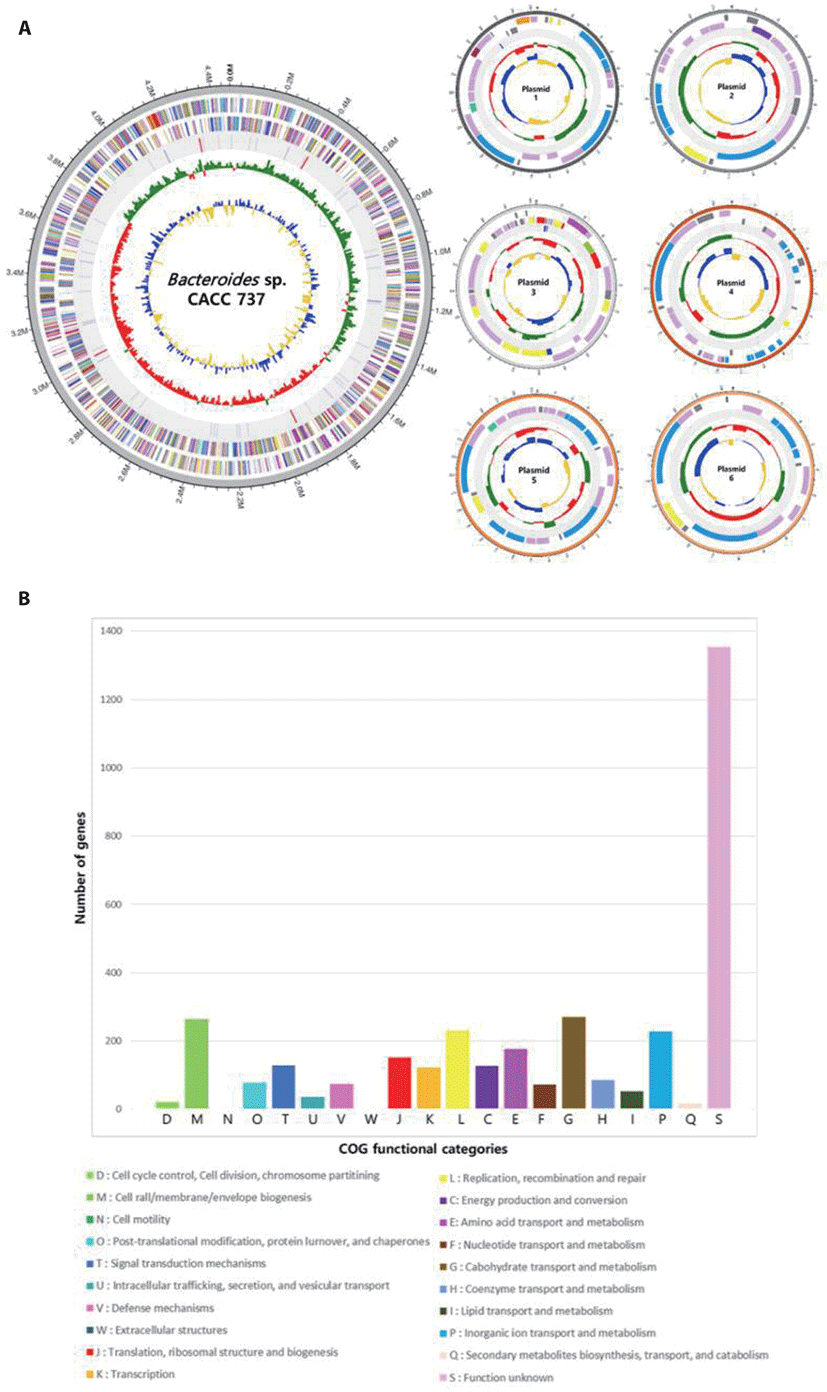ANNOUNCEMENT
Bacteroides species are gram-negative, anaerobic, non-spore-forming, bile-resistant bacteria that reside in the gut. They constitute approximately 25% to 30% of the intestinal gut microbiota of humans and other animals [1]. These bacteria have been proposed as next-generation probiotics by virtue of the action on the intestinal immune system [2]. In companion animals, Bacteroides associated with immune proteins, such as Tumor necrosis factor (TNF)-α and decreased the relative abundance with chronic enteropathy [3,4].
We isolated Bacteroides sp. CACC 737 (KACC 22065) from the feces of a male 9-year-old Persian chinchilla in Korea. The sample was incubated in anaerobic atmosphere (5% carbon dioxide, 5% hydrogen, and 90% nitrogen) at 37°C for 48 h on De, Rogosa and Sharpe (MRS) media. The isolate was considered to be a novel species of Bacteroides based on its 16S rRNA sequence that displayed the highest similarity to the type strain B. uniformis ATCC8492T (97.5%), which was below the suggested novel species recognition threshold of 98.6% [5]. Genomic DNA was extracted from CACC 737 cell pellets using a DNeasy UltraClean microbial kit (QIAGEN, Hilden, Germany), consistent with the manufacturer’s instructions. The isolated DNA was sequenced using single molecular real-time Portal (v2.3) with the PacBio RS II system (Pacific Biosciences, Menlo Park, CA, USA; Macrogen, Seoul, Korea). The annotation of the genome sequences was carried out using the combined results of the automatic National Center for Biotechnology Information Prokaryotic Genomes Annotation Pipeline and the Rapid Annotations Subsystems Technology prokaryotic genome annotation server (http://rast.nmpdr.org) [6]. The clustered regularly interspaced short palindromic repeats (CRISPR) were assessed using CRISPR web server (http://crispr.i2bc.paris-saclay.fr) [7,8].
Bacteroides species harbor cryptic plasmids at a high frequency (50%) [9]. The complete genome of Bacteroides sp. CACC 737 genome revealed six cryptic plasmids ranging from 20 to 40 kb with an average GC content of 40.9% as well as a single circular chromosome of 4,470,359 bp with a GC content of 46.0% (Table 1 and Fig. 1A). The genome also contained 13 rRNAs and 69 transfer RNAs. A total of 3,938 protein-coding sequences (CDSs) were identified. Plasmids include hypothetical proteins and include genes involved in carbohydrate metabolism. Furthermore, 3,938 CDSs were specifically to clusters of 20 Clusters of Orthologous Groups of proteins (COGs)-based functional categories (Fig. 1B). Many genes were classified into functional categories for carbohydrate transport and metabolism (n = 270), cell wall/membrane/envelope biogenesis (n = 263), recombination and repair (n = 231), inorganic ion transport and metabolism (n = 227), amino acid transport and metabolism (n = 176), translation, ribosomal structure, and biogenesis (n = 151).

Two confirmed CRISPR regions (1 and 2) and one questionable CRISPR 9 region were detected. The pattern was identified as the CRISPR-CAS II type. The characterization of type II elements may reveal molecular genome editing tools for the development of next-generation probiotics [10]. The complete genome sequence of Bacteroides sp. CACC 737 will provide fundamental knowledge of the probiotic effects in host healthcare.
The complete genome of strain CACC 737 has been deposited to the National Center for Biotechnology Information GenBank database under accession numbers CP059408 (chromosome) and CP059406, CP059407, CP059409 - CP059412 (plasmids).
